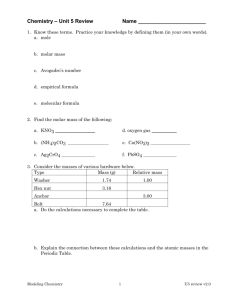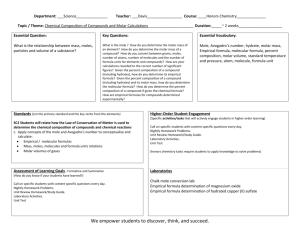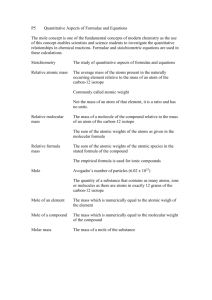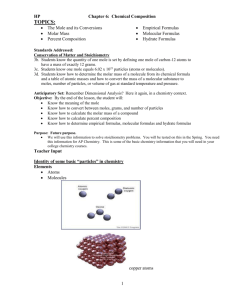Chapter 11—The Mole Measuring Matter Counting Particles
advertisement
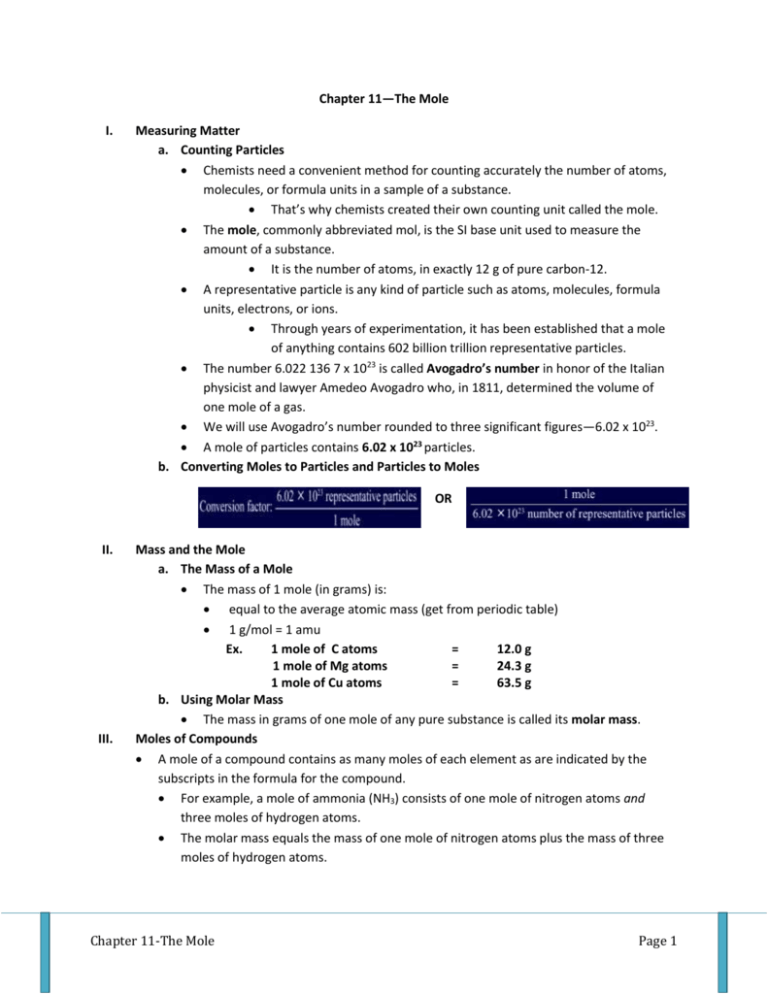
Chapter 11—The Mole I. Measuring Matter a. Counting Particles Chemists need a convenient method for counting accurately the number of atoms, molecules, or formula units in a sample of a substance. That’s why chemists created their own counting unit called the mole. The mole, commonly abbreviated mol, is the SI base unit used to measure the amount of a substance. It is the number of atoms, in exactly 12 g of pure carbon-12. A representative particle is any kind of particle such as atoms, molecules, formula units, electrons, or ions. Through years of experimentation, it has been established that a mole of anything contains 602 billion trillion representative particles. The number 6.022 136 7 x 1023 is called Avogadro’s number in honor of the Italian physicist and lawyer Amedeo Avogadro who, in 1811, determined the volume of one mole of a gas. We will use Avogadro’s number rounded to three significant figures—6.02 x 1023. A mole of particles contains 6.02 x 1023 particles. b. Converting Moles to Particles and Particles to Moles OR II. III. Mass and the Mole a. The Mass of a Mole The mass of 1 mole (in grams) is: equal to the average atomic mass (get from periodic table) 1 g/mol = 1 amu Ex. 1 mole of C atoms = 12.0 g 1 mole of Mg atoms = 24.3 g 1 mole of Cu atoms = 63.5 g b. Using Molar Mass The mass in grams of one mole of any pure substance is called its molar mass. Moles of Compounds A mole of a compound contains as many moles of each element as are indicated by the subscripts in the formula for the compound. For example, a mole of ammonia (NH3) consists of one mole of nitrogen atoms and three moles of hydrogen atoms. The molar mass equals the mass of one mole of nitrogen atoms plus the mass of three moles of hydrogen atoms. Chapter 11-The Mole Page 1 IV. Empirical and Molecular Formulas a. Percent Composition Recall that every chemical compound has a definite composition—a composition that is always the same wherever that compound is found. Percent composition is the percent by mass of each element in the compound. The percent of an element in a compound can be found in the following way. 1. Calculate the molar mass of compound 2. Calculate percent by mass of element Unit = % Report percents to 2 decimal places Always check to make sure percentages add up to 100%. b. Empirical Formula You can use percent composition data to help identify an unknown compound by determining its empirical formula. The empirical formula is the simplest whole-number ratio of atoms of elements in the compound. In many cases, the empirical formula is the actual formula for the compound. For example, the simplest ratio of atoms of sodium to atoms of chlorine in sodium chloride is 1 atom Na : 1 atom Cl. So, the empirical formula of sodium chloride is Na1Cl1, or NaCl, which is the true formula for the compound. c. Molecular Formula For many compounds, the empirical formula is not the true formula. A molecular formula tells the exact number of atoms of each element in a molecule or formula unit of a compound. Notice that the molecular formula for acetic acid (C2H4O2) has exactly twice as many atoms of each element as the empirical formula (CH2O). The molecular formula for a compound is always a whole-number multiple of the empirical formula. In order to determine the molecular formula for an unknown compound, you must know the molar mass of the compound in addition to its empirical formula. Then you can compare the molar mass of the compound with the molar mass represented by the empirical formula as shown in the following example problem. Chapter 11-The Mole Page 2 V. The Formula of a Hydrate A hydrate is a compound that has a specific number of water molecules bound to its atoms. b. Naming Hydrates In the formula for a hydrate, the number of water molecules associated with each formula unit of the compound is written following a dot Na2CO3 10H2O Name: sodium carbonate decahydrate The mass of water associated with a formula unit must be included in molar mass calculations. c. Analyzing a Hydrate To analyze hydrates, you must drive off with water with heat. The resulting compound is called anhydrous (without water). To determine the formula for a hydrate you must find the number of moles of water associated with one mole of the hydrate. The difference between the mass of the hydrate & the mass of the anhydrous compound = the water in the hydrate Now you can calculate the ratio of moles of water to moles of compound to determine the coefficient that precedes water Chapter 11-The Mole Page 3
